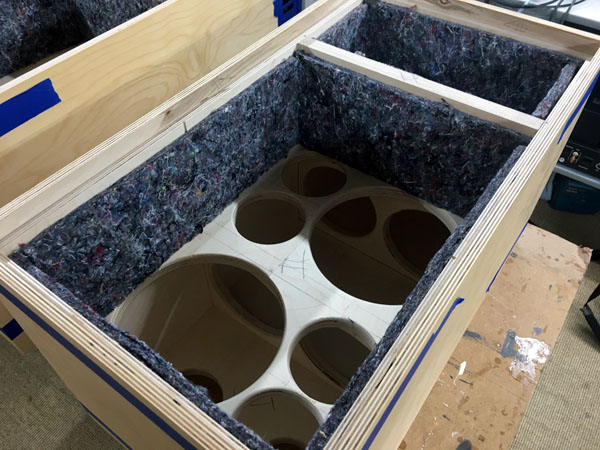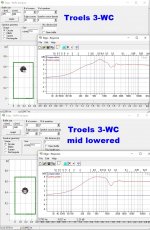........... The woofer offset between front / rear mounting will be about 0.02 m or less, which is less than 3% of the wavelength at x-over. You can ignore that.
Correct
Attachments
Last edited:
To me it looks like mid-on-top just makes cabinet construction easier

Midline positioning makes edge interferences symmetrical, and they are not in tweeter range anyway in this case.
Mid on top and running to 2,5kHz with LR2 is where the sound comes from!

Midline positioning makes edge interferences symmetrical, and they are not in tweeter range anyway in this case.
Mid on top and running to 2,5kHz with LR2 is where the sound comes from!
Attachments
It would be interesting to ask those questions to Troels. Is he on diyAudio? I am sure he had good reasons to do what he did. Loudspeaker design is all about compromises! There is no such thing as a perfect loudspeaker that ticks all boxes...
That's a good point. But why did Troels make a chamber for the tweeter? Isn't the tweeter sealed anyway? The tweeter chamber sort of defeats the "make it simple" argument.
The symmetry of the edge diffractions is exactly what one would want to avoid. Off-center placement would help spreading the diffraction effects from the left/right edges to different frequencies, so they would not add up at the same frequencies.
Also, the tweeter will have much less beaming than the midrange. It will therefore "see" the edges more than the midrange, resulting in more diffraction. Can you do the Edge simulations for the tweeter?
The plots show the horizontal dispersion in a relatively narrow window of +/-30°. In this rather narrow angular window dispersion is largest between 2 kHz and 5 kHz. I can see why dispersion is less below 2 kHz, but I don't understand why it's less above 5 kHz, since the the x-over is quoted as 2.5 kHz, so the tweeter should be dominant from about 3 kHz and up, and there should not be much beaming. Maybe the x-over overlap between the midrange and tweeter is a bit larger than one might think?
Think again. What you hear is not just the direct "on axis" sound from the speaker, but the entire sound energy emitted from the speaker into the room. A single on-axis SPL curve (or a few horizontal off axis curves at +/-30°) will not tell you how a speaker sounds. A full blown dispersion plot like in your avatar (Juhazi) tells you much more about how a speaker sounds (including horizontal and vertical measurements out to at least +/-90°, but it's best to use measurements covering the full 4pi sphere). A power response curve showing the summed sound energy emitted into the room may also be useful to tell how a speaker sounds.
Single SPL curves are interesting mostly from an engineering point of view, for example to check if the x-over filters work as intended. In terms of "how does it sound?", such "single SPL curves" are not very meaningful.
To me it looks like mid-on-top just makes cabinet construction easier
That's a good point. But why did Troels make a chamber for the tweeter? Isn't the tweeter sealed anyway? The tweeter chamber sort of defeats the "make it simple" argument.
Midline positioning makes edge interferences symmetrical, and they are not in tweeter range anyway in this case.
The symmetry of the edge diffractions is exactly what one would want to avoid. Off-center placement would help spreading the diffraction effects from the left/right edges to different frequencies, so they would not add up at the same frequencies.
Also, the tweeter will have much less beaming than the midrange. It will therefore "see" the edges more than the midrange, resulting in more diffraction. Can you do the Edge simulations for the tweeter?
he posts a horizontal dispersion plot which looks more than acceptable to me. perhaps this is why he kept the tweeter on the centreline.
The plots show the horizontal dispersion in a relatively narrow window of +/-30°. In this rather narrow angular window dispersion is largest between 2 kHz and 5 kHz. I can see why dispersion is less below 2 kHz, but I don't understand why it's less above 5 kHz, since the the x-over is quoted as 2.5 kHz, so the tweeter should be dominant from about 3 kHz and up, and there should not be much beaming. Maybe the x-over overlap between the midrange and tweeter is a bit larger than one might think?
i don’t expect the vertical to be so pretty but i tend to listed whilst sitting at various places around a room such that my ears are mostly at a constant height so this is less important to me
Think again. What you hear is not just the direct "on axis" sound from the speaker, but the entire sound energy emitted from the speaker into the room. A single on-axis SPL curve (or a few horizontal off axis curves at +/-30°) will not tell you how a speaker sounds. A full blown dispersion plot like in your avatar (Juhazi) tells you much more about how a speaker sounds (including horizontal and vertical measurements out to at least +/-90°, but it's best to use measurements covering the full 4pi sphere). A power response curve showing the summed sound energy emitted into the room may also be useful to tell how a speaker sounds.
Single SPL curves are interesting mostly from an engineering point of view, for example to check if the x-over filters work as intended. In terms of "how does it sound?", such "single SPL curves" are not very meaningful.
Tweeter has a box in the construction plan, but I can't see it in photos!
Mid on surface and recessed tweeter is to get best time alignment. Troels is very picky about it, but now he just doesn't say it.
(My avatar shows normalized horizontal dispersion of AINOgradient. It is too tall to get measured vertically up to 180deg. In my thread there are some vertical measurements, lobing of mid-tweeter is evident)
Mid on surface and recessed tweeter is to get best time alignment. Troels is very picky about it, but now he just doesn't say it.
(My avatar shows normalized horizontal dispersion of AINOgradient. It is too tall to get measured vertically up to 180deg. In my thread there are some vertical measurements, lobing of mid-tweeter is evident)
Last edited:
That's good! I always wonder why nobody's doing it...especially with woofers that are more than 4". The air moved gets consistent in pressure with such gigantic membranes inside the enclosure.IBut why did Troels make a chamber for the tweeter? Isn't the tweeter sealed anyway? The tweeter chamber sort of defeats the "make it simple" argument.
Somebody tries to isolate the tweeter with gel or something, either.
I prefer other techniques 🙄
That's good! I always wonder why nobody's doing it...especially with woofers that are more than 4". The air moved gets consistent in pressure with such gigantic membranes inside the enclosure.
The sound pressure depends on how loud you set the music, not on the size of the woofer. For a given volume setting, a smaller membrane will just have more excursion to create the same pressure as a larger woofer.
I still don't understand the purpose of the tweeter chamber.
I still don't understand the purpose of the tweeter chamber.
For the pressure matter, so you don't stress the structure ( glue etc.) of the tw
I was talking about the vibrations transmitted by the woofer and midrange, which travel along the wooden structure. But keeping out the air pressure is one good point
Member
Joined 2009
Paid Member
i can only imagine that the tweeter chamber was included in the design for two reasons, a) because Troels had not finalised his tweeter selection. He obviously was aiming to build this to a cost to make it a more popular design than those using more expensive drivers and cross-overs, b) you don’t have to be so careful with sealing the tweeter to the baffle when you are doing experiments
If you take (a little) time to read the entire Troels page which are talking about:
"You can make a small cabinet around tweeter magnet - I actually forgot. Not a big deal, but doesn't hurt. "
"You can make a small cabinet around tweeter magnet - I actually forgot. Not a big deal, but doesn't hurt. "
No wonder he forgot it!
Do you remember any other speaker plan that has subenclosure for the tweeter? There are some tweeters that have open/vented rear chamber, but right now I can't remember any.
I think it is much easier to make good seal for the tweeter flange than to make an airtight subenclosure.
Do you remember any other speaker plan that has subenclosure for the tweeter? There are some tweeters that have open/vented rear chamber, but right now I can't remember any.
I think it is much easier to make good seal for the tweeter flange than to make an airtight subenclosure.
When using a waveguide its sometimes helpful to use a sealed tweeter cavity in case the waveguide to tweeter interface is not perfectly sealed.
Member
Joined 2009
Paid Member
true, but we're not using a waveguide with this project.
I understand, that is why the chamber is unnecessary in this case. Someone asked about why you'd need a tweeter chamber and i stated one such situation.
Also I am amazed at the amount of criticism of Troel's design based on little - if any - direct experience of the design.
no kidding
It would make far more sense for this thread to be split.
Somehow it appears to have become a Monkey thread...I think by unintended pirating.
Also I am amazed at the amount of criticism of Troel's design based on little - if any - direct experience of the design.
If you tried to use it as a canoe it would be difficult to steer with such a blunt end.It would be better with a pointed bow like top.Also if it had a hinged front baffle and a small refrigeration motor/compressor built in you could use it as a bar fridge.So lots of design considerations have been overlooked.
If you tried to use it as a canoe it would be difficult to steer with such a blunt end.It would be better with a pointed bow like top.Also if it had a hinged front baffle and a small refrigeration motor/compressor built in you could use it as a bar fridge.So lots of design considerations have been overlooked.
hahaha!
Member
Joined 2009
Paid Member
....I am amazed at the amount of criticism...
and you’ve been a member since 2005 ? ! 😀
Maybe that is why I normally steer clear of speaker threads!!! [ There do seem to be a lot of people with keen commercial interests in cross-over design using very heavy component counts of extremely expensive components.]
Last edited:
- Home
- Loudspeakers
- Multi-Way
- Troels Gravesen high efficiency 3-way looks like a winner.

